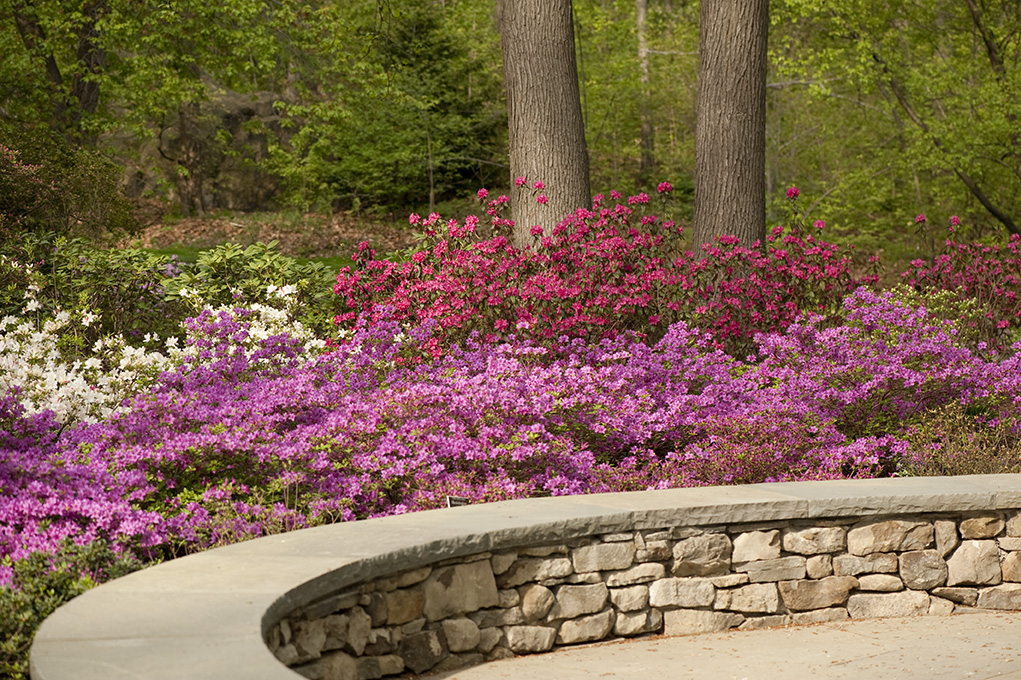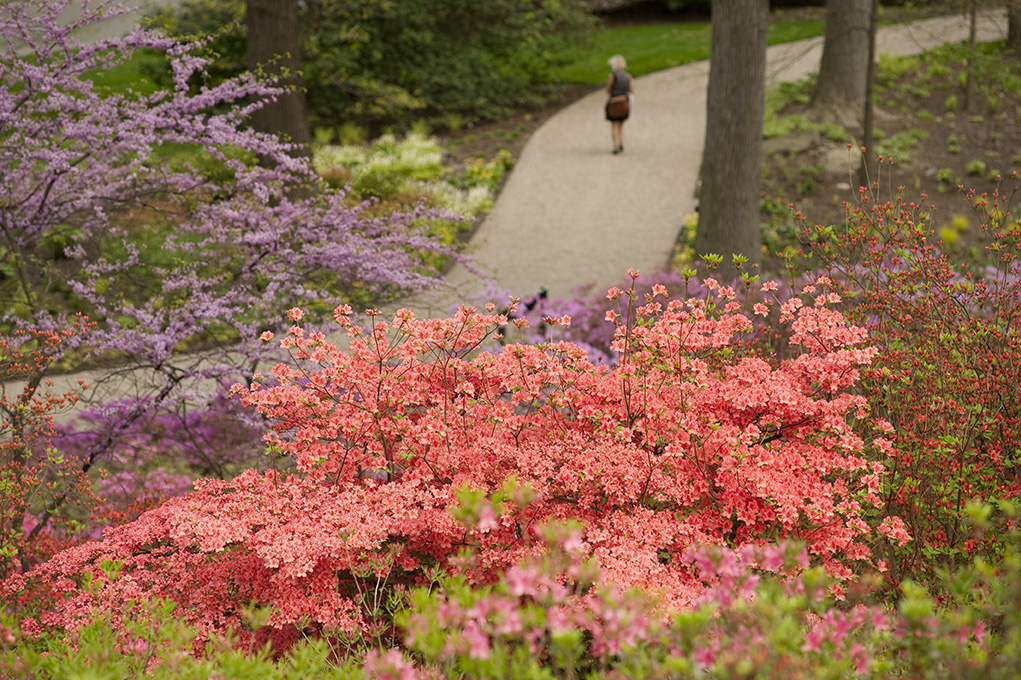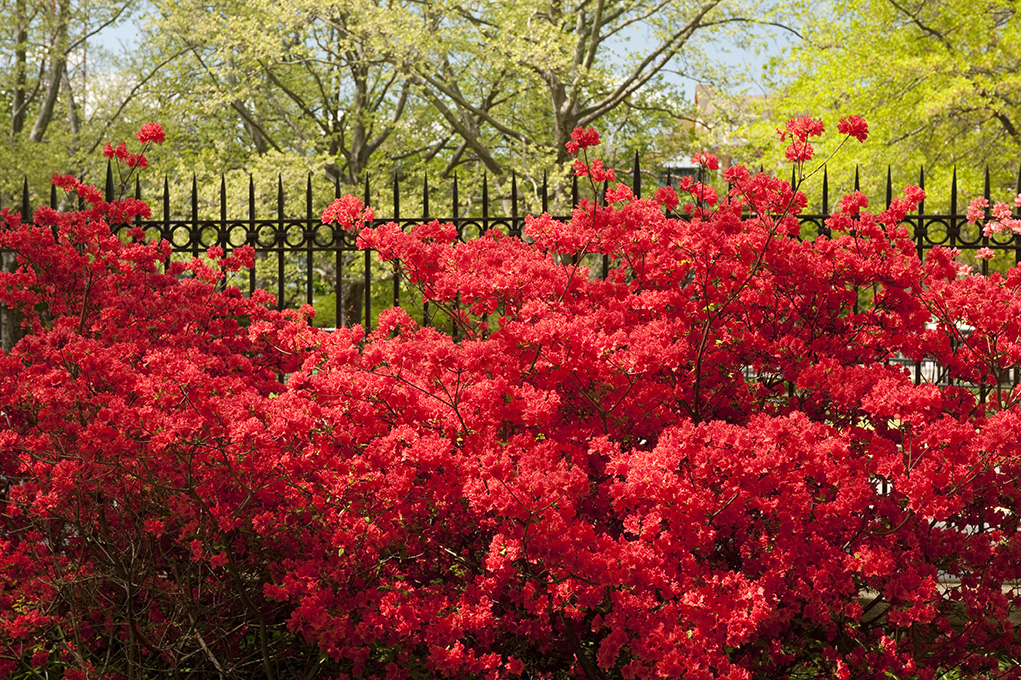Azalea Planting Tips
Posted in Gardening Tips on May 10 2011, by Sonia Uyterhoeven
 |
Sonia Uyterhoeven is Gardener for Public Education. |
As discussed last week, good site conditions such as a soil pH of between 4.5 and 6, soil rich in organic matter, good drainage, and a part-shade to full-sun environment including protection from strong winds are essential for the health of azaleas. Be sure to research basic information about the azaleas you are purchasing including color and bloom time, its ultimate size, growth habit, and hardiness When planting azaleas, it is important to provide enough space between them for sufficient light and air circulation. Plant labels and catalogs generally supply appropriate spacing information for both the height and width of the azalea.
Chances are that the azaleas you purchase will have been grown in a container, either in a soil-less potting medium or a mixture of composted bark and sand. While these are fine mediums for plants grown in a container, making them easier to care for, the potting mediums are very different in structure from native soil, and water will not flow freely from one to the other. Often, the native soil around the newly planted azalea will be moist while the root ball remains dry. Because of this, the day before planting, water your potted azaleas so that they are well hydrated but not too soggy.
If you have good drainage, plant your azaleas at the same level to the soil as they were in the container. The planting holes should be the same depth as the container and 3-5 times as wide, with sloping sides. Most of the roots on each azalea will be growing in the top 12 inches of the soil, extending outward rather than downward. The goal in making a wide hole is to loosen the soil in the area of maximum root growth. Remember, azaleas are a shallow rooting plant. Do not dig the hole excessively deep, otherwise the root ball will sink and settle too low. If you have clay soil, you can plant your azaleas slightly higher than grade (1 to 2 inches higher). Sometimes azaleas are planted 6 inches higher with great success. To do this, add coarse sand and leaf compost to the backfill and grade on a slight slope.

For more inspiration visit the amazing, new Azalea Garden.
When removing an azalea from its container, take care to protect the tiny hair-like feeder roots along the main roots, which can be torn if the plant is pulled from its base straight from the container. Instead, for a small container, with one hand cup the top of the container around the stem. Tip the container upside down–cradling the plant with the cupped hand–and slide it out of the container. If the root ball sticks to the container, tap it against a firm surface to dislodge the plant from the pot. For a large container, two people may be needed to hold and tip the container or to lay it on its side and gently slide the plant out.
If an azalea is pot-bound–meaning that the roots have wrapped around the root ball–it will be necessary to loosen the roots before planting, otherwise they will grow in a way that compromises the health of the plant. There are several ways to loosen the root system. If the roots are slightly pot-bound, tease them out gently by hand. If the roots are tightly wound around the root ball and hard to loosen, make three or four slits vertically down the side of the root ball about a half-inch to three-quarters of an inch deep. One of the newer techniques for handling a pot-bound shrub is to plant the root ball first, without loosening the roots, and then slice off approximately three-quarters of an inch (or less) all around the root ball with a sharp spade. Sheering off the outer layer of roots after it is in the ground gives the root ball more structural support so that it doesn’t get damaged or collapse by the force of the spade.
Before planting your azalea in its newly dug hole, amend the soil if needed. In an ideal world you would amend as large an area as possible around the plantings, because if just the planting hole is amended, the roots may stay in the rich amended area and not move out into the surrounding soil. The wider the planting hole the better. The general rule is to add one-quarter to one-third the quantity of organic matter to the hole; you can eyeball this amount. If you are gardening in heavy clay or sand, incorporate organic matter such as leaf compost.

See also: Azaleas A to Z: Know Them to Grow Them
When planting a shrub, it is helpful to add mycorrhizal or soil inoculants to encourage active soil microorganisms (read the package directions). Fertilizer can be incorporated into the backfill at planting time, though at the Garden we often wait until the second season. Do not fertilize heavily or use one high in nitrogen, which will promote top growth rather than root growth. At the Garden we often use an organic fertilizer specifically for Ericaceous plants, Holly-tone® 4-3-4.
Place the root ball into the hole and slowly fill in with the backfill. Either gently firm the soil down as you go so that there are no air pockets around the roots, or water the hole when it is halfway filled with soil, let the water subside, and finish filling the hole. Build a temporary berm (a slightly raised edge) about 3–4 inches tall around the perimeter of the root ball with any excess soil you may have. This will act as a reservoir, concentrating the water in the root ball area. Keep this temporary berm in place for 6–8 weeks.

See also: Top Tips for Designing with Azaleas in the Home Garden
It is imperative to mulch your azaleas. The maximum depth is generally around two inches–mulch out, not up. Taper off the mulch so that it doesn’t touch the plant, which can potentially cause pest and disease problems.
Check your newly planted azaleas every other day for about 2-3 weeks to make sure the root balls don’t dry out. Water as necessary and then once a week through the first season, until the azaleas are established. Your azalea will need an inch of water (including rain water) each week or a half-gallon per square foot.


Thanks for having this fact sheet available to gardeners